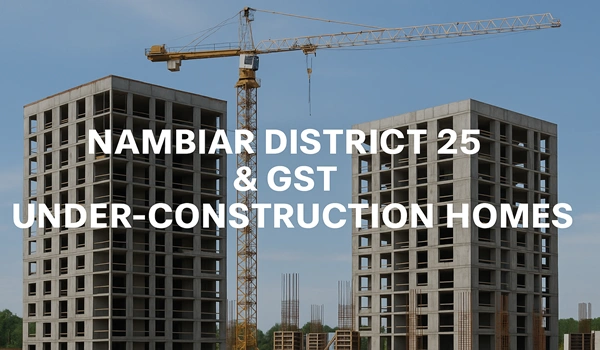When buying an apartment at Nambiar District 25, it’s important to know that the advertised price is not the final amount you’ll pay. When buying an under-construction property, you need to consider stamp duty, registration fees, and Goods and Services Tax (GST). Many buyers forget to budget for it, only to face a surprise later. This blog explains in simple terms how GST works, what the rate is, and how it affects your overall budget.
The Goods and Services Tax (GST) started in 2017 to make India’s indirect tax system simpler. In real estate, GST applies only to under-construction properties that don’t yet have a Completion Certificate (CC). Once a project receives a CC, it is treated as “ready-to-move,” and no GST is charged.
At Nambiar District 25, most homes are still under construction, so GST will apply to buyers.
As of August 2025, the GST rates are:
For buyers at Nambiar District 25, the applicable rate will almost always be 5%, since prices here are above the affordable housing bracket.
You don’t pay GST on the full property price. By law, one-third of the price is treated as land value (which is exempt). GST is charged only on the remaining two-thirds.
Formula: GST = (Apartment Price × 2/3) × 5%
Example A: 2 BHK priced at ₹1.57 crore
Example B: 3 BHK priced at ₹2 crore
So, while the brochure shows ₹1.57 crore or ₹2 crore, the real cost is higher once GST is included.
Banks usually finance base price + GST + stamp duty + registration, provided the loan amount is within your eligibility. This means your EMI calculations should include GST too.
For example, if your loan covers ₹1.25 crore, adding ₹5–7 lakh of GST increases the borrowed amount and raises your EMI slightly. Ignoring this early can strain your monthly budget later.
At Nambiar District 25, the 5% GST on under-construction homes can add between ₹5–7 lakh to your total cost, depending on the unit size. Ready-to-move homes avoid this tax, but most current phases are still under construction. When planning your purchase, always account for GST along with other statutory costs to avoid last-minute surprises.
The GST rates and examples in this blog are correct as of August 2025. These rules may change in the future. Please check the latest GST, stamp duty, and registration charges on the official Karnataka government website or confirm with your bank before making payment.
